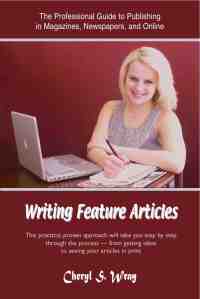I’m so excited to announce the arrival and release of my new book for writers. It’s now in my hot little hands and for sale from the back of my van. (I jest. Well, sort of. But not entirely.)
The book is a practical, how-t0, hands-on, step-by-step guide for getting published today. It’s perfect for anyone who has dreams of getting published, but doesn’t quite know how to get started and where to go.
The entire publishing process is covered in the book, with everything from coming up with marketable ideas, to writing query letters, to writing leads, to working with editors (and everything in between) highlighted.
It also includes a number of “extras”–“Writer Spotlight” interviews with professional writers and editors, “Writing Advantage” sidebars, sample query letters and articles, and learning exercises with every chapter.
The chapters in the book will give you a good idea of what you can expect between its covers:
1: Magazine Writing Today
2: Writing Features for Newspapers
3: Writing for Online Publications
4: Writing for Trade Publications
5: The Magazine Article
6: The Writing Process
7: Generating Ideas
8: Marketing Your Writing
9: Query Letters
10: Research & Interviews
11: Writing a Feature Article: Structure
12: Outlining, Drafting, Revising
13: Writing a Feature Article: Style
14: Final Steps to Publication
15: Business, Legal, & Ethical Practices
The book will be marketed as a textbook to college feature writing and magazine writing courses, but it is also a wonderful resource for aspiring freelance writers (or successful writers who want a jumpstart to their work).
I’m looking forward to talking about the topics in the book to writing groups and at writing conferences in the next months. If you would like to have me as a speaker for your group, let me know and I will get you on my schedule (email me at cherylswray@gmail.com; comment on this post; or visit me at “Cheryl Sloan Wray” or at “Writing with Cheryl” on Facebook).
If you’d like a copy of the book, let me know and I can mail one off to you. It retails to colleges for $31.95, but I can sell individual copies for $20. (I’ll even autograph it for you!)
A new book is always an exciting thing…and I’m especially excited that my book is designed to help writers find publishing success.
(Look for more things here related to the book soon. I will be posting some excerpts, speaking news, and other items related to it.)
Have a wonderful…and productive…Friday and weekend.








